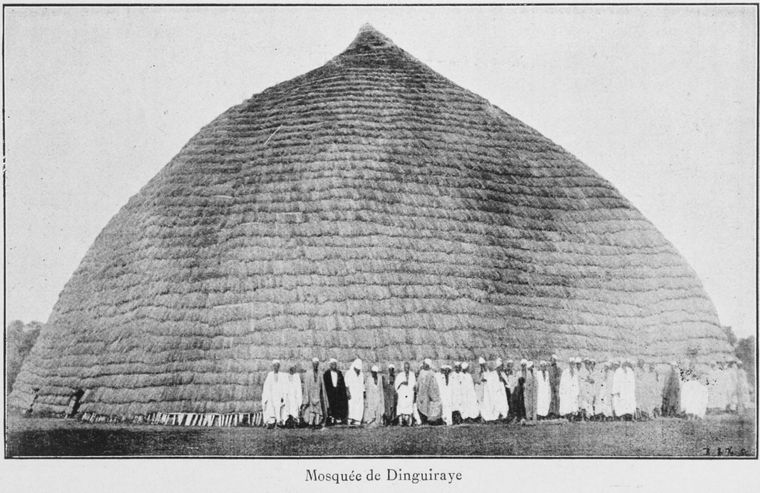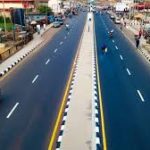The point of embarkation for our journey to the holy city of Dinguerai, was Dabola. I have seen very picturesque towns within a five day period of travel: Mamou; Timbo; TimbiMadina; Sokotoro; Labe; Dalaba and Dabola. The Nigerian Ambassador, Doctor Aisha Labraba Abdullahi, wanted us to leave Dabola early the following morning, because the roads are said to be very bad in these parts of Guinea. Well, we left early enough and the road was not really good insome parts, but we had a long stretch that was not tarred but wasn’t too bad either. The scenery was very superb and early in the morning; the sun was rising from behind mountains that smoked rather like an old African villager with a pipe! There were villages with the uniquely round architecture of the huts and the circular mosques so unique to the Futa Djallon. I stopped the convoy of two four-wheel vehicles to take pictures of the mosques, the huts and sometimes the people and their wares; they also asked questions but were generally very friendly. These were Jalunke villages; they were the original inhabitants of Futa before the Fulbe people came to take over the rolling hills, hence the name of the region, Futa Djallon: the place of the Fulbe and the Jalunke!
Dinguerai is the holy city founded by the great Jihadist, El-hajj Oumarou Tall. At the heart of the town is the great mosque built by El-Hajj Oumarou himself and that was in the traditional form until it was re-built a few years ago! Islam and remembrances of the life and times of El-Hajj Oumarou Tall seemed to be the central staples of existence in this holy town. But the first point of call for us was the office of the local administration; they were obviously surprised that we came that far, and it took a while for them to organize our meetings. After about 45 minutes of waiting, we were met by Alpha Ahmadou Bah, the Deputy Imam of the Grand Mosque of Dinguerai. A young man, Bah said that in the holy town sometimes in the nineteenth century, was so cosmopolitan, that the languages spoken in Dinguerai included Toucoleur, Fulfulde, Bambara, Malinke and Hausa. In fact, the last person who spoke Hausa was a lady called Madina Gaye, who died ten years ago.
El-Hajj Oumarou Tall had made the pilgrimage to the Holy lands of Islam during the 19th century. He was said to be a very learned man, and the legend in Dinguerai, was that Tall was the first Blackman to lead prayers in the Hijaz. On the way, he met Sheikh Usmanu Dan Fodiyo, and that led to the establishment of a relationship. The main element of that relationship was the marriage between El-Hajj Tall and the daughter of Dan Fodiyo, Fatoumata. The Caliph of Dinguerai, is El-Hajj Mountaga Tall; he said that Sheikh Fodiyo and El-Hajj Tall were friends who made very important jihads during the 19th century in West Africa. It was that friendship which led to the consummation of the marriage with Fatoumata, Sheikh Fodiyo’s daughter. This was consummated, according to Tall, in 1852. The story went that when FatoumataHaoussawas coming to Dinguerai, she was accompanied by one hundred people from Sokoto, and that was the basis of the flourishing of the Hausa language in the holy city of Dinguerai for almost a hundred years!
As we were to also discover, El-Hajj Oumarou Tall seemed to like Nigerian women particularly, because he was said to have married two other women from here; these were Nana SaturAisha from Kano and Nana Borno Marietu. The granddaughter of the wife from Borno, is one of the oldest women in Dingureai, at the age of 95 years. HajiaOumou Sharif is granddaughter of El-Hadji Oumarou Tall and is a Sharifa! Her great grandmother was also from Kano, and the name was Hassanatou. The very light-skinned, slender and elderly woman told me that all their parents spoke Hausa, and even she remembered a few words of the language. But all of them remembered the legend of FatoumataHaoussa, the daughter of Sheikh Usmanu Dan Fodiyo. “She was a very good Muslim who liked everybody”, was the way she was remembered by HajiaOumou.
This was similar to the way that the Caliph, El-Hajj Mountaga Tall described the place of Fatoumata in the history of Dinguerai. She was a true representative of her roots in Sokoto; she was a very religious woman; a blessed woman who loved God and the Prophet Muhammad. “FatoumatahHaoussah did not go where God was not; she entered a house of Islam from a house of Islam and really brought honour to this community and after the marriage, the Jihad grew stronger”. FatoumatahHaoussah would eventually give birth to three sons: Habib, Mouktar and Mahmoud as well as a daughter, Khadijatou. The Caliph also told us that Sir Ahmadu Bello, the Sardauna of Sokoto and former Premier of Northern Nigeria visited Dinguerai in 1964. We stopped over in the residence of 102 years old HajiaOummu Tall, who is said to be oldest person in Dinguerai. She informed us that she has in her possession a book written by Shehu Usman Dan Fodiyo. She is the last remaining child of El-Hajj Oumar Tall, and remembers all that used to be said about FatoumataHaoussa: she was a pious woman, who gave birth to equally lovely children. Her origins as the daughter of the great Sheikh Usmanu Dan Fodiyo was something which everybody in the community remember.
Ahmadou Baba Tall is a great grandson of FatoumataHaoussa; he is blind and crippled, but he remembers stories about his great grandmother. “She was always with her mother when she was young, in Sokoto. Anything she was doing, she asked her mother’s point of view and she had tremendous love for her father, the Sheikh Usmanu Dan Fodiyo; it was the same love that she would transfer to El-Hajj Oumarou Tall when they got married and she moved from Nigeria to Guinea. As we finished the discussion with Ahmadou Baba Tall, it was time for the Zuhr prayer and that took us to the great mosque built by El-Hajj Oumarou Tall but re-built by the late Guinean President, Lansana Conte. The architects tried very pleasantly to stay faithful to the original concept of the mosque, from El-Hajj Tall’s time.
After the prayer, the community was informed that we had come all the way to Dinguerai from Nigeria to explore the historical relationships which dated back to our fathers, Dan Fodiyo and El-Hajj Tall. The Nigerian Ambassador, Dr. Aisha Laraba Abdullahi, gave an account of the rich historical links between our peoples, promising to ensure that those links are given a new impetus, in the context of the realities of today. One of the plans she has, is to ensure the twinning of the cities of Sokoto and Dinguerai and also work for the families of Dan Fodiyo and El-Hajj Tall to re-discover themselves; something which Sir Ahmadu Bello commenced with his visit in 1964, a visit that is still remembered very vividly in Dinguerai. It was at the mosque, that we received a counter-information, that Fatoumata actually died in 1852 and not that she was brought to Dinguerai in that year. El-Hajj OumarouTall’s visit to Sokoto is also part of the legend of the city; he met Sheikh Dan Fodiyo and was very well received as a scholar and religious leader. To show the respect between the two religious leaders, Fatoumata was given to Tall as a wife; she gave birth to El-Hajj Tall’s first son, Mouktar, who died and was buried in Segou, in present-day Mali. The people in the mosque also remembered that 100 people followed Fatoumata from Sokoto; our visit is therefore seen, as being in the foot step of both FatoumataHaoussa in the nineteenth century and Sir Ahmadu Bello in 1964!
As we finished the meeting with the community in the grand mosque, I was accosted by a 47 year old Businessman, Mahmoud Tall; he came with a picture taken in 1964 by Sir Ahmadu Bello and the late Alhaji Karamoko Tall, Mahmoud’s own father. The late Karamoko Tall was the son of Ahmadou Tall who was the son of Habib Tall whose mother was FatoumataHaoussa, the daughter of Sheikh Usmanu Dan Fodiyo! In a visit that has lasted about five hours, we were clearly breathing life into history with all the stories we have heard as well as in the people we have met. I asked for an opportunity to take a picture of the tomb of FatoumataHaoussa and we were obliged. She died in 1852, and there we were, squatting around a grave which had a small headstone, with her name written in the Arabic. We were told that it was in the hand writing of El-Hajj Oumar Tall himself. As we prayed for her repose, my eyes became moist about the finality of death as well as the continuity of life; finality, because Fatoumata lied in the soil of Dinguerai, so far away from where she was born, in what would become modern Northern Nigeria. However, there is also continuity in the lives of the descendants she left and the legend which has outlived her. In Dinguerai, in the modern Republic of Guinea, thousands of miles from Northern Nigeria, the legend of FatoumataHaoussa, the daughter of Sheikh Usman Dan Fodio lives on today, 157 years after her death.


